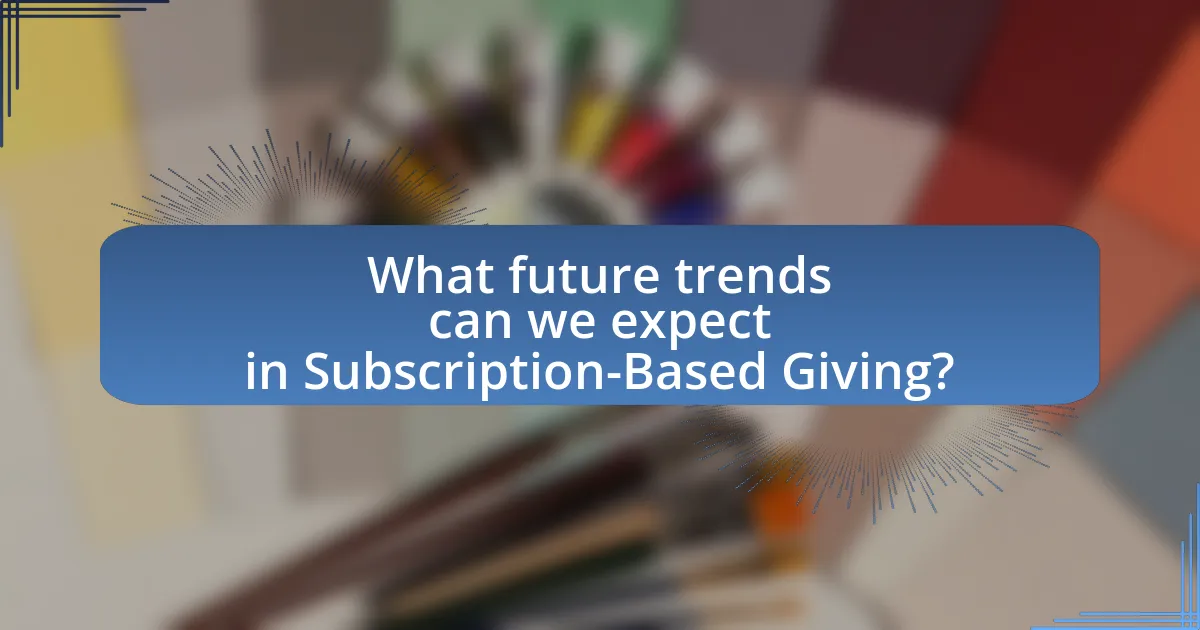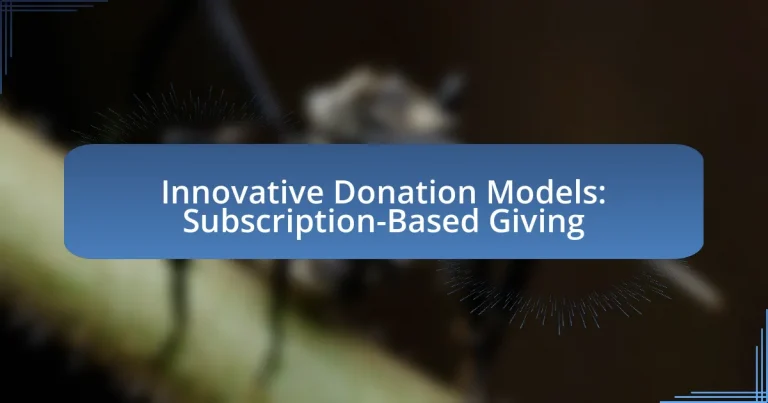Innovative donation models, particularly subscription-based giving, represent a transformative approach to fundraising that enhances donor engagement and provides nonprofits with predictable revenue streams. This model allows donors to make regular, recurring contributions, fostering long-term relationships and increasing overall financial support. The article explores how subscription-based giving differs from traditional donation methods, its key features, benefits for charities, and the challenges organizations face in implementation. Additionally, it discusses strategies for effective engagement, the role of technology, and future trends shaping this innovative giving landscape.

What are Innovative Donation Models and Subscription-Based Giving?
Innovative donation models refer to new and creative approaches to fundraising that enhance donor engagement and increase financial support for causes. Subscription-based giving is a specific type of innovative donation model where donors commit to making regular, recurring contributions, often on a monthly basis, to a nonprofit organization or cause. This model provides a predictable revenue stream for organizations and fosters long-term relationships with donors, as evidenced by studies showing that recurring donors typically contribute more over time compared to one-time donors.
How does Subscription-Based Giving differ from traditional donation methods?
Subscription-Based Giving differs from traditional donation methods primarily in its recurring nature and predictable revenue stream. While traditional donations are often one-time contributions, subscription-based giving involves donors committing to regular, scheduled payments, which can enhance financial stability for organizations. For example, a study by the Nonprofit Finance Fund found that organizations utilizing subscription models experienced a 30% increase in donor retention rates compared to those relying solely on one-time donations. This model allows nonprofits to plan budgets more effectively and allocate resources efficiently, demonstrating a significant shift in how charitable contributions are structured.
What are the key features of Subscription-Based Giving?
Subscription-Based Giving is characterized by recurring donations made by individuals to support a cause or organization on a regular basis. This model typically includes features such as automated payment processing, which simplifies the donation process for both the donor and the organization, ensuring consistent funding. Additionally, it often provides donors with the flexibility to choose the frequency and amount of their contributions, enhancing donor engagement and commitment. Subscription-Based Giving also fosters a sense of community among donors, as they often receive updates and reports on the impact of their contributions, reinforcing their connection to the cause. This model has been shown to increase donor retention rates, as evidenced by studies indicating that recurring donors are more likely to continue their support over time compared to one-time donors.
Why is Subscription-Based Giving gaining popularity among donors?
Subscription-Based Giving is gaining popularity among donors due to its convenience and the ability to provide ongoing support to causes they care about. This model allows donors to contribute smaller amounts regularly, making philanthropy more accessible and sustainable. Research indicates that 70% of millennials prefer subscription services, reflecting a broader trend towards recurring payments in various sectors, including charitable giving. Additionally, organizations benefit from predictable revenue streams, which enhances their planning and impact capabilities.
What are the potential benefits of Subscription-Based Giving for charities?
Subscription-Based Giving offers charities consistent revenue streams, enhancing financial stability. This model allows charities to predict cash flow more accurately, facilitating better planning and resource allocation. According to a study by the Charitable Giving Research Institute, organizations utilizing subscription models reported a 30% increase in donor retention rates compared to traditional one-time donations. Additionally, subscription-based giving fosters stronger relationships between donors and charities, as regular contributions can lead to increased engagement and loyalty. This model also simplifies the donation process for supporters, making it easier for them to contribute regularly without the need for repeated decision-making.
How does Subscription-Based Giving provide a steady revenue stream?
Subscription-Based Giving provides a steady revenue stream by establishing recurring donations from supporters, which creates predictable income for organizations. This model allows nonprofits to forecast their financial needs more accurately, as they can rely on a consistent flow of funds each month or year. Research indicates that organizations utilizing subscription-based models often experience higher donor retention rates, with studies showing that recurring donors contribute 42% more annually than one-time donors. This financial stability enables nonprofits to plan long-term projects and allocate resources effectively, ensuring sustainability and growth.
What impact does Subscription-Based Giving have on donor engagement?
Subscription-Based Giving significantly enhances donor engagement by fostering a sense of community and commitment among donors. This model encourages regular contributions, which can lead to increased donor retention rates; studies indicate that subscription-based models can improve donor loyalty by up to 50% compared to traditional one-time donations. Additionally, the predictable revenue stream allows organizations to plan and execute long-term projects, further engaging donors by demonstrating the tangible impact of their contributions. This ongoing relationship is reinforced through regular updates and personalized communication, which are more feasible in a subscription framework, ultimately leading to deeper connections between donors and the cause.
What challenges do organizations face with Subscription-Based Giving?
Organizations face several challenges with Subscription-Based Giving, including donor retention, fluctuating revenue, and administrative complexities. Donor retention is critical, as organizations must continually engage subscribers to prevent cancellations; studies show that subscription services often experience churn rates of 5% to 10% monthly. Fluctuating revenue poses a risk, as monthly donations can vary significantly, making financial planning difficult; for instance, a 2021 report indicated that 30% of nonprofits reported inconsistent income from subscription models. Administrative complexities arise from managing multiple subscriptions, requiring robust systems for tracking and communication, which can strain resources. These challenges necessitate strategic approaches to ensure sustainability and growth in subscription-based giving.
How can organizations overcome donor fatigue in Subscription-Based Giving?
Organizations can overcome donor fatigue in Subscription-Based Giving by enhancing donor engagement through personalized communication and demonstrating the impact of contributions. Personalized updates and stories about how donations are utilized can foster a deeper connection between donors and the cause, making them feel valued and informed. Research indicates that organizations that regularly communicate the outcomes of donations experience higher donor retention rates, as seen in a study by the Association of Fundraising Professionals, which found that 70% of donors prefer to receive updates on the impact of their contributions. Additionally, offering flexible giving options and incentives, such as exclusive content or recognition, can further motivate donors to maintain their subscriptions, thereby reducing fatigue.
What are the technological requirements for implementing Subscription-Based Giving?
The technological requirements for implementing Subscription-Based Giving include a secure payment processing system, a user-friendly online platform, and robust data management capabilities. A secure payment processing system is essential to handle recurring transactions safely, ensuring compliance with financial regulations and protecting donor information. A user-friendly online platform facilitates easy navigation for donors, allowing them to set up, manage, and modify their subscriptions effortlessly. Robust data management capabilities are necessary to track donations, analyze donor behavior, and generate reports for transparency and accountability. These components collectively enable organizations to effectively manage subscription-based giving models.

How can organizations effectively implement Subscription-Based Giving?
Organizations can effectively implement Subscription-Based Giving by creating a user-friendly platform that allows donors to easily set up recurring contributions. This involves integrating a seamless payment processing system, ensuring transparency in how funds are utilized, and providing regular updates to subscribers about the impact of their donations. Research indicates that organizations using subscription models can increase donor retention rates by up to 50%, as consistent engagement fosters a sense of community and commitment among supporters.
What strategies can enhance the success of Subscription-Based Giving campaigns?
To enhance the success of Subscription-Based Giving campaigns, organizations should implement targeted marketing strategies, personalized donor engagement, and transparent communication. Targeted marketing strategies, such as utilizing social media and email campaigns, can effectively reach potential subscribers by highlighting the impact of their contributions. Personalized donor engagement, including tailored messages and recognition, fosters a sense of belonging and encourages ongoing support. Transparent communication about how funds are utilized builds trust and accountability, which is crucial for retaining subscribers. Research indicates that campaigns with clear impact reporting see a 20% increase in donor retention rates, demonstrating the effectiveness of these strategies.
How can organizations tailor their messaging for Subscription-Based Giving?
Organizations can tailor their messaging for Subscription-Based Giving by emphasizing the long-term impact of consistent contributions. Highlighting specific projects or initiatives that benefit from ongoing support can create a sense of connection and urgency. For instance, organizations can share success stories that illustrate how monthly donations have led to tangible outcomes, such as funding educational programs or providing essential services. Research indicates that donors are more likely to engage when they see the direct effects of their contributions, as evidenced by a study from the Nonprofit Research Collaborative, which found that 70% of donors prefer to know how their money is being used. By focusing on transparency and the measurable impact of subscription-based donations, organizations can effectively motivate potential donors to commit to regular giving.
What role does social media play in promoting Subscription-Based Giving?
Social media plays a crucial role in promoting Subscription-Based Giving by facilitating engagement and awareness among potential donors. Platforms like Facebook, Instagram, and Twitter enable organizations to share compelling stories, updates, and calls to action that resonate with audiences, thereby encouraging recurring donations. According to a report by the Pew Research Center, 69% of adults in the U.S. use social media, which provides a vast audience for nonprofits to reach and engage. Additionally, social media allows for targeted advertising, enabling organizations to reach specific demographics likely to support subscription-based models. This targeted approach can significantly increase donor retention and acquisition, as evidenced by a study from the Nonprofit Research Collaborative, which found that organizations utilizing social media effectively saw a 30% increase in donor engagement.
What are some successful examples of Subscription-Based Giving?
Successful examples of Subscription-Based Giving include platforms like Patreon, which allows creators to receive recurring donations from supporters, and Donorbox, which enables nonprofits to set up subscription donations easily. Patreon has over 200,000 creators and has facilitated over $2 billion in payments to them, demonstrating its effectiveness in fostering ongoing financial support. Donorbox has helped thousands of nonprofits implement subscription models, with features that allow donors to choose their giving frequency and amount, thus enhancing donor retention and engagement. These platforms exemplify how subscription-based giving can create sustainable funding streams for individuals and organizations.
How have specific organizations leveraged Subscription-Based Giving effectively?
Organizations like Patreon and Tipeee have effectively leveraged Subscription-Based Giving by creating platforms that allow creators to receive ongoing financial support from their fans. Patreon, for instance, enables artists and content creators to offer tiered subscription levels, providing exclusive content and rewards to subscribers, which has resulted in over 200,000 creators earning a collective $1 billion since its inception. Tipeee similarly allows users to support creators through monthly contributions, fostering a direct relationship between supporters and creators. This model not only ensures a steady income stream for creators but also builds a community around their work, enhancing engagement and loyalty among subscribers.
What lessons can be learned from these successful models?
Successful models of subscription-based giving demonstrate that consistent, predictable revenue streams enhance donor engagement and retention. These models show that by providing donors with a seamless and automated giving experience, organizations can increase their overall fundraising efficiency. For instance, research indicates that subscription-based donations can lead to a 30% increase in donor retention rates compared to traditional one-time donations. Additionally, successful models highlight the importance of transparency and communication, as regular updates on the impact of donations foster trust and encourage ongoing support.

What future trends can we expect in Subscription-Based Giving?
Future trends in Subscription-Based Giving include increased personalization, integration with technology, and a focus on community engagement. Personalization will allow donors to tailor their contributions to specific causes or projects, enhancing their connection to the impact of their giving. Integration with technology, such as mobile apps and automated payment systems, will streamline the donation process, making it easier for individuals to contribute regularly. Additionally, organizations will likely emphasize community engagement, fostering a sense of belonging among subscribers through exclusive content, updates, and events. These trends are supported by the growing demand for transparency and accountability in charitable giving, as evidenced by a 2022 report from the Charitable Giving Report, which highlighted that 70% of donors prefer to see the direct impact of their contributions.
How is technology shaping the future of Subscription-Based Giving?
Technology is significantly shaping the future of Subscription-Based Giving by enabling seamless, automated donation processes and enhancing donor engagement through personalized experiences. Digital platforms facilitate recurring donations, allowing donors to set up automatic contributions with minimal effort, which increases the likelihood of sustained support for charitable organizations. For instance, services like Patreon and Substack have popularized subscription models, demonstrating that consistent, small contributions can accumulate to substantial funding over time. Additionally, data analytics tools allow organizations to tailor their outreach and communication strategies, improving donor retention rates. According to a 2022 report by the Charitable Giving Report, subscription-based giving has seen a 25% increase in participation, highlighting the effectiveness of technology in driving this innovative donation model.
What innovations are emerging in the Subscription-Based Giving landscape?
Innovations in the Subscription-Based Giving landscape include the integration of technology to enhance donor engagement and streamline the giving process. Platforms are now utilizing automated recurring donations, allowing donors to set up contributions that automatically renew, which increases donor retention rates. Additionally, gamification elements are being introduced, where donors can track their impact and receive rewards for their contributions, fostering a sense of community and encouraging higher donation levels. Furthermore, personalized giving experiences are emerging, with data analytics being used to tailor communication and donation options to individual preferences, thereby increasing the likelihood of sustained support. These innovations are supported by studies indicating that personalized engagement can lead to a 50% increase in donor retention.
How might donor expectations evolve in the coming years?
Donor expectations are likely to evolve towards greater transparency and accountability in the coming years. As technology advances, donors increasingly demand detailed insights into how their contributions are utilized, with 70% of donors expressing a preference for organizations that provide regular updates on the impact of their donations. Additionally, the rise of subscription-based giving models is expected to shift donor expectations towards more consistent engagement and personalized communication from organizations, reflecting a desire for ongoing relationships rather than one-time transactions. This evolution is supported by trends indicating that 60% of millennials prefer to support causes through recurring donations, highlighting a shift in how donors view their role in philanthropy.
What best practices should organizations follow for Subscription-Based Giving?
Organizations should implement clear communication, flexible giving options, and regular engagement strategies as best practices for Subscription-Based Giving. Clear communication ensures that donors understand the impact of their contributions, which can increase retention rates; for instance, organizations that provide detailed updates on how funds are used report higher donor satisfaction. Flexible giving options, such as allowing donors to choose their subscription amount or frequency, cater to diverse financial situations and preferences, enhancing participation. Regular engagement through newsletters, social media updates, and personalized thank-you messages fosters a sense of community and belonging among subscribers, which studies show can lead to increased loyalty and long-term support.
How can organizations maintain transparency and trust with subscribers?
Organizations can maintain transparency and trust with subscribers by providing clear, consistent communication about how donations are utilized. Regularly sharing detailed reports on financial allocations and project outcomes fosters accountability. For instance, a study by the Charities Aid Foundation found that 70% of donors are more likely to trust organizations that openly disclose their financial information. Additionally, implementing feedback mechanisms allows subscribers to voice concerns and suggestions, further enhancing trust.
What metrics should organizations track to measure the success of Subscription-Based Giving?
Organizations should track metrics such as Monthly Recurring Revenue (MRR), subscriber growth rate, churn rate, donor retention rate, and average donation per subscriber to measure the success of Subscription-Based Giving. MRR indicates the predictable revenue generated from subscriptions, while the subscriber growth rate reflects the effectiveness of marketing and outreach efforts. Churn rate measures the percentage of subscribers who cancel, providing insight into donor satisfaction and engagement. Donor retention rate assesses how well organizations maintain their subscriber base over time, and average donation per subscriber helps evaluate the financial contribution of each donor. Collectively, these metrics provide a comprehensive view of the performance and sustainability of Subscription-Based Giving initiatives.

